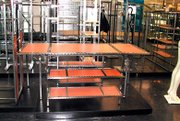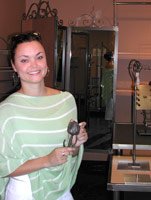Aaron's Raw Steel Fixtures
Call the star performer of Acme Display Fixture & Packaging by the name of “Aaron.”
Acme rolled out Aaron Contemporary, its line of raw-steel fixtures, in July 1998. By 2003, the new line accounted for more than 25 percent of the company’s $15 million in sales, said Mitch Blumenfeld, vice president of the 56-year-old Los Angeles–based company.
Aaron Contemporary will be celebrating its sixth birthday next month. The line is named after another 6-year-old: Aaron Berenzweig, the son of company owners Richard and Lucy Berenzweig.
The line has helped the company grow rapidly. After Aaron’s debut, the business acquired a 67,000-square-foot showroom/shipping plant in Duarte, Calif., expanded its 8,000-square-foot warehouse on South Olive Street to 25,000 square feet and doubled the size of its showroom in the California Market Center to 4,000 square feet.
Blumenfeld said Aaron Contemporary has been successful because it presents an alternative to the chrome-colored fixtures that dominate the look of many retail stores.
Instead of chrome’s bright polish, the raw steel in the Aaron fixtures, covered by organiclooking scratches and imperfections, looks like it was just produced by the foundry.
Nicole Levey, managing partner of Beverly Hills–based infant apparel store Maba, said the fixtures’ style has helped support the individual personality of the store.
“I didn’t want something that looked like it fit in a department store,” Levey said. “It was supposed to look like something you’d put in your home.”
The company developed Aaron Contemporary at a crucial time. By the late 1990s, Acme was looking for a product that would cast the company in a bold new light. Since 1948, the company had been selling mannequins, rolling racks, slat walls and, yes, chrome fixtures but needed something to make it stand out from the pack.
Blumenfeld felt that Aaron Contemporary could be the product to define the company. Acme knew it was onto something when it ran out of catalogs for the fixtures at the 1998 MAGIC International trade show in Las Vegas. The promise was realized when the product proved popular enough for the company to expand the collection from its original 15 pieces, mostly floor-rack displays for hanging clothes, to more than 175 pieces, including a giant three-way mirror ($975), rolling racks ($145) and jewelry displays (starting at $50).
Acme keeps Aaron Contemporary fresh by regularly developing new looks for the collection. The fixture company debuted the Hammered Tech collection early this year. The line features tables and racks made out of pear wood with a metal tubing border that looks like it was artfully indented by a hammer.
Another new addition, Satin Chrome, is made out of aluminum and differentiated from regular chrome by a soft, light finish.
Custom-made pieces are part of Aaron’s charm. One top custom-made seller includes finials, or decorations, on the tops of racks and stands. Acme has designed various finial shapes, including roses and hearts made out of forged steel.
Blumenfeld said customers give the company ideas. Once Acme gets a demand for a particular item, the company asks one of its more than 25 free-lance craftsmen to make a prototype. Then Acme employees mold and change the piece until the company is comfortable selling it in the marketplace.
Aaron will keep its unfinished steel looks at reasonable prices despite rising steel costs, which have increased four times since November 2003, Blumenfeld said. Acme executives said they keep Aaron Contemporary prices down through discounts the company receives by pre-committing orders to California steel foundries.
The company also hopes the popularity of the steel fixtures will stick around as long as Acme co-founder Pauline Heideman, who worked four days a week at Acme until her death at age 99 in 1998.
“She was a fixture in the place,” Blumenfeld said. “We still get people walking into the store and asking for her.”
Richard Berenzweig, the current president and Blumenfeld’s cousin, is Heideman’s grandnephew.























